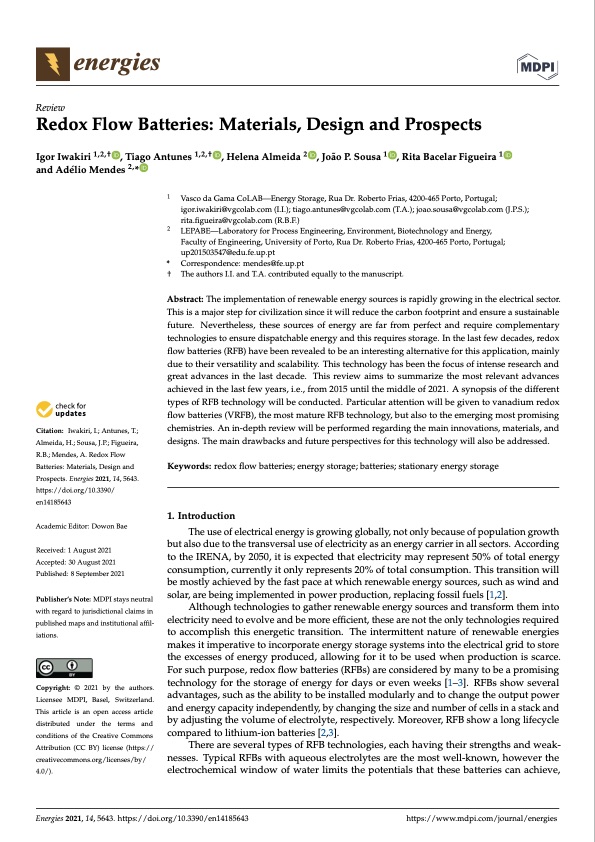
PDF Publication Title:
Text from PDF Page: 001
energies Review Redox Flow Batteries: Materials, Design and Prospects Igor Iwakiri 1,2,† , Tiago Antunes 1,2,† , Helena Almeida 2 , João P. Sousa 1 , Rita Bacelar Figueira 1 and Adélio Mendes 2,* Citation: Iwakiri,I.;Antunes,T.; Almeida, H.; Sousa, J.P.; Figueira, R.B.; Mendes, A. Redox Flow Batteries: Materials, Design and Prospects. Energies 2021, 14, 5643. https://doi.org/10.3390/ en14185643 Academic Editor: Dowon Bae Received: 1 August 2021 Accepted: 30 August 2021 Published: 8 September 2021 1 2 up201503547@edu.fe.up.pt * Correspondence: mendes@fe.up.pt † The authors I.I. and T.A. contributed equally to the manuscript. Abstract: The implementation of renewable energy sources is rapidly growing in the electrical sector. This is a major step for civilization since it will reduce the carbon footprint and ensure a sustainable future. Nevertheless, these sources of energy are far from perfect and require complementary technologies to ensure dispatchable energy and this requires storage. In the last few decades, redox flow batteries (RFB) have been revealed to be an interesting alternative for this application, mainly due to their versatility and scalability. This technology has been the focus of intense research and great advances in the last decade. This review aims to summarize the most relevant advances achieved in the last few years, i.e., from 2015 until the middle of 2021. A synopsis of the different types of RFB technology will be conducted. Particular attention will be given to vanadium redox flow batteries (VRFB), the most mature RFB technology, but also to the emerging most promising chemistries. An in-depth review will be performed regarding the main innovations, materials, and designs. The main drawbacks and future perspectives for this technology will also be addressed. Keywords: redox flow batteries; energy storage; batteries; stationary energy storage 1. Introduction The use of electrical energy is growing globally, not only because of population growth but also due to the transversal use of electricity as an energy carrier in all sectors. According to the IRENA, by 2050, it is expected that electricity may represent 50% of total energy consumption, currently it only represents 20% of total consumption. This transition will be mostly achieved by the fast pace at which renewable energy sources, such as wind and solar, are being implemented in power production, replacing fossil fuels [1,2]. Although technologies to gather renewable energy sources and transform them into electricity need to evolve and be more efficient, these are not the only technologies required to accomplish this energetic transition. The intermittent nature of renewable energies makes it imperative to incorporate energy storage systems into the electrical grid to store the excesses of energy produced, allowing for it to be used when production is scarce. For such purpose, redox flow batteries (RFBs) are considered by many to be a promising technology for the storage of energy for days or even weeks [1–3]. RFBs show several advantages, such as the ability to be installed modularly and to change the output power and energy capacity independently, by changing the size and number of cells in a stack and by adjusting the volume of electrolyte, respectively. Moreover, RFB show a long lifecycle compared to lithium-ion batteries [2,3]. There are several types of RFB technologies, each having their strengths and weak- nesses. Typical RFBs with aqueous electrolytes are the most well-known, however the electrochemical window of water limits the potentials that these batteries can achieve, Vasco da Gama CoLAB—Energy Storage, Rua Dr. Roberto Frias, 4200-465 Porto, Portugal; igor.iwakiri@vgcolab.com (I.I.); tiago.antunes@vgcolab.com (T.A.); joao.sousa@vgcolab.com (J.P.S.); rita.figueira@vgcolab.com (R.B.F.) LEPABE—Laboratory for Process Engineering, Environment, Biotechnology and Energy, Faculty of Engineering, University of Porto, Rua Dr. Roberto Frias, 4200-465 Porto, Portugal; Publisher’s Note: MDPI stays neutral with regard to jurisdictional claims in published maps and institutional affil- iations. Copyright: © 2021 by the authors. Licensee MDPI, Basel, Switzerland. This article is an open access article distributed under the terms and conditions of the Creative Commons Attribution (CC BY) license (https:// creativecommons.org/licenses/by/ 4.0/). Energies 2021, 14, 5643. https://doi.org/10.3390/en14185643 https://www.mdpi.com/journal/energiesPDF Image | PNNL Vanadium Redox Flow Battery Stack

PDF Search Title:
PNNL Vanadium Redox Flow Battery StackOriginal File Name Searched:
energies-14-05643-v2.pdfDIY PDF Search: Google It | Yahoo | Bing
Salgenx Redox Flow Battery Technology: Salt water flow battery technology with low cost and great energy density that can be used for power storage and thermal storage. Let us de-risk your production using our license. Our aqueous flow battery is less cost than Tesla Megapack and available faster. Redox flow battery. No membrane needed like with Vanadium, or Bromine. Salgenx flow battery
| CONTACT TEL: 608-238-6001 Email: greg@salgenx.com | RSS | AMP |